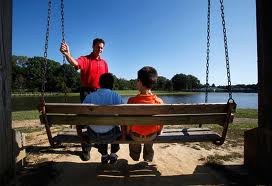We often point proudly to Memphis’ history as a place where innovative, smart entrepreneurs have charted new paths and defied predictions.
We know the names: from Smith to Hyde, from Plough to Saunders, from Dunavant to Rose. But there’s another name that belongs on the list – Patrick Lawler, chief executive officer of Youth Villages – and we were reminded of it in recent headlines from coast to coast.
Here’s a headline from the Washington Post: “The simple way one Tennessee program turns foster kids into higher-earning adults.”
Or as the Nashville Tennessean wrote: “A Tennessee foster care program has done something never before documented by researchers: made life better, at least a little bit, for a group of foster children who turned 18 and left state care.”
Committed Early
It’s the fulfillment of a vision that began for Mr. Lawler when he was in his early 20s and was stalking the halls of Shelby County Government in pursuit of special funding for Dogwood Village, the forerunner to Youth Villages. He could foresee better outcomes for children who were victims of physical abuse, sexual abuse, suicidal thoughts and attempts, and drug addiction.
It was at the time when the federal government distributed money to governments across the country with no strings attached. Shelby County Government got its share, and the competition for some of it was stiff. But although he was only a few years out of high school in the late 1970s (in fact when he was 18 years old, he was a counselor at the old Tall Trees Guidance Facility for youths), he impressed county officials with his concept for a residential facility to give at-risk teenagers better options in life.
Some people counted him out, but he became a in the County Administration Building as common as Shelby County’s first mayor, elected a couple of years earlier. In the end, Shelby County Government used the federal funding for two purposes: Youth Villages and LINC, the Memphis and Shelby County library system’s information referral program.
Accolades
It was about 1978 and it was a much simpler time. LINC consisted of file after file of index cards filled with information, and Dogwood Village was an idea that mostly just seemed a nice thing to do.
But Mr. Lawler had another plan. In 1979, he founded Dogwood Villages, and five years later, it launched its first capital campaign, and in 1986, it changed its name to Youth Villages. By 1991, it was becoming a statewide program, and in 1992, it began the foster care program that would put it on the national map.
By 1997, Youth Villages opened its first office outside of Tennessee, and three years later, it was destination as a national model by the National Coalition for Juvenile Justice (in the next few years, it would receive similar recognition from the American Youth Policy forum and United Way of America). In 2005, Edna McConnell Clark Foundation gave Youth Villages a grant and its support would prove pivotal in the nonprofit organization’s work.
The following year, Mr. Lawler was called one of “America’s best leaders” by U.S. News and World Report in conjunction with Harvard University’s John F. Kennedy School Government. In 2009, Harvard Business School spotlighted Youth Villages in a case study, “Leading and Governing Highly Effective Nonprofit Organizations” and the White House included it among four organizations that offer “promising ideas that are transforming communities.”
Multiple Successes
Today, Youth Villages has grown from two small residential facilities to serving more than 23,000 families each year in 70 locations in more than 20 states and Washington, D.C. The centerpieces of its programs are residential campuses located in natural surroundings where children live in cottages or cabins. Every campus has a school, gym, and swimming pool. But its real focus is keeping at-risk children in their own communities.
In other words, Mr. Lawler has devoted his entire life to serving our most vulnerable children, which brings us to the recent national publicity about the effectiveness of its foster programs.
For many years, there was evidence that Youth Villages’ foster children program was delivering impressive results, but it moved from evidence to fact with a recent study by MDRC, a respected social policy research organization. The study heading: “Study Shows Boost to Positive Outcomes for Young Adults Aging Out of Foster Care and Juvenile Justice – Large, Rigorous Study Finds Youth Villages Program Increases Economic Well-Being, Reduces Homelessness.”
The findings: Youth Villages YVLifeSet program boosted earnings, increased housing stability, and economic well-being and improved health outcomes. It was all firsts for the program for multiple improved outcomes for youths turning 18 and aging out of the foster care and juvenile justice systems.
Results
Former foster children across the U.S. are about twice as likely to end up involved with law enforcement and 36% of former foster kids are homeless at the age of 26. They often receive less education and make much less money. In fact, the median annual income for former foster children is only $9,000 a year, one-third of what people who were not foster children earn.
MDRC tracked 1,322 young adults in Tennessee between the ages of 18 and 24 who had recently “aged out” of foster care or the juvenile custody system. Just under 800 of them entered a program operated by Youth Villages, and the remaining people were treated as the control group.
People in the Youth Villages program received weekly counseling from a case manager for up to nine months to have wide-ranging discussions about how to improve decisions and advance their lives. A year after receiving this additional attention, researchers interviewed them again and found that the Youth Village participants were 22% less likely to be homeless and 19% less likely to have “couch surfed” than their peers in the control group. Their part-time earnings were 18% higher for Youth Village participants.
Essentially, the research showed that we can pay now or pay later. The Youth Services cost per person is about $10,000, but the cost of failure runs many times higher in terms of criminal justice, incarceration, welfare, and less income.
Experts Here At Home
At a time when billions of dollars are wasted on programs with no data-driven success, Youth Villages now has a national spotlight on its successful programs. With an emphasis on building strong families for children threatened with foster home after foster home and with the understanding that once youths are in the system, they tend to stay there, the goal of Youth Villages is to break the cycle.
Its Evidentiary Family Restoration program has a long-term success rate – 80% — that is twice the national average of traditional services and at one-third of the costs of traditional care. Youth Villages believes that half of the more than 600,000 boys and girls being raised by the state could live safely at home with the families with proper support systems and intensive work. That’s what Youth Villages provides.
And what it does better than almost any nonprofit organization is to collect data in an unbiased and professional way, to measure outcomes meticulously, to base programs on the information, and to remain flexible enough to respond to individual needs.
With its record of success, we’ve always been surprised that local government doesn’t have Mr. Lawler as a special adviser on youth. After all, he’s asked to testify before Congress and prestigious hearings across the country.
No one else in this community can boast of a national reputation for this kind of success, and with so many at-risk children, we need the smartest people we can get to help us out. The good news is that many of these people can be found right here at Youth Villages.
***
Join us at the Smart City Memphis Facebook page for daily articles, reports, and commentaries that are relevant to Memphis.






